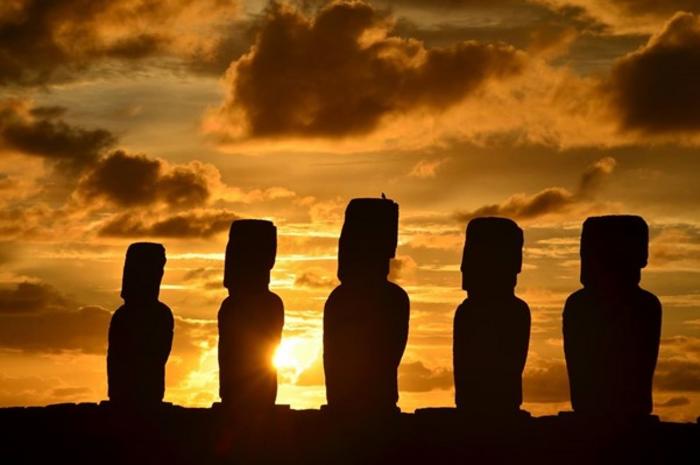Summary: New genetic analysis of ancient Rapa Nui (Easter Island) inhabitants refutes the popular “ecocide” theory and confirms pre-European contact with Indigenous Americans, challenging long-held beliefs about the island’s history.
Estimated reading time: 7 minutes
A groundbreaking study published in Nature has rewritten key aspects of Rapa Nui’s history, commonly known as Easter Island. By analyzing the genomes of 15 ancient Rapanui individuals who lived between 1670 and 1950, researchers have debunked a popular theory of population collapse and provided strong evidence for pre-European contact with the Americas.
Rapa Nui, one of the world’s most isolated inhabited places, has long captivated researchers and the public alike. Its rich archaeological record, including the iconic moai statues, has fueled intense debate about the island’s past. This new research, led by an international team of scientists from the University of Copenhagen and the University of Lausanne, addresses two major controversies in Rapanui history.
Debunking the “Ecocide” Theory
For decades, Rapa Nui’s history has been presented as a cautionary tale of resource overexploitation. The “ecocide” theory proposed that the Rapanui population, which may have reached over 15,000 individuals, triggered dramatic environmental changes on the island. These changes, including widespread deforestation, were thought to have led to resource scarcity, warfare, and even cannibalism, culminating in a catastrophic population collapse in the 1600s.
However, the genetic analysis conducted in this study found no evidence to support this theory. Bárbara Sousa da Mota, a researcher at the University of Lausanne and first author of the study, explains: “Our genetic analysis shows a stably growing population from the 13th century through to European contact in the 18th century. This stability is critical because it directly contradicts the idea of a dramatic pre-contact population collapse.”
The researchers expected to find a genetic signature of a population collapse, such as a sudden drop in genetic diversity. Instead, they discovered a picture of resilience, with the Rapanui population facing environmental challenges over several centuries until the disruptions brought by European contact after 1722.
Pre-European Contact with the Americas
The study also provides compelling evidence for pre-European contact between Polynesians and Indigenous Americans. Previous genetic studies of contemporary Rapanui individuals had hinted at such contact, but earlier ancient DNA analyses had not found evidence to support this hypothesis.
By generating high-quality ancient genomes, the research team found that about 10% of the Rapanui gene pool has an Indigenous American origin. Crucially, they were able to infer that this genetic mixing occurred before Europeans arrived on the island or in the Americas.
Assistant Professor Víctor Moreno-Mayar from the University of Copenhagen, another first author of the study, states: “We looked into how the Indigenous American DNA was distributed across the Polynesian genetic background of the Rapanui. This distribution is consistent with a contact occurring between the 13th and the 15th centuries.”
While the study cannot pinpoint where this contact occurred, it suggests that Rapanui ancestors may have reached the Americas before Christopher Columbus.
Why It Matters
This research has significant implications for our understanding of Polynesian history and capabilities:
- It challenges long-held beliefs about the fragility of the Rapanui society, highlighting their resilience in the face of environmental changes.
- The study provides strong evidence for impressive maritime capabilities of Polynesian peoples, suggesting they may have voyaged further than previously thought.
- It demonstrates the importance of ancient DNA analysis in resolving historical debates and correcting potentially biased narratives.
Associate Professor Anna-Sapfo Malaspinas from the University of Lausanne, the study’s last author, emphasizes the broader significance: “While it is well established that the environment of Rapa Nui was affected by anthropogenic activity, such as deforestation, we now know that these changes did not lead to a population collapse.”
Implications for Future Research and Repatriation Efforts
The study’s findings have important implications beyond academic circles. The researchers worked closely with members of the Rapanui community and the “Comisión Asesora de Monumentos Nacionales” in Rapa Nui (CAMN) to ensure the research addressed questions of interest to both scientists and the community.
One key finding was that the populations closest to the ancient Rapanui are indeed those currently living on the island. This information is crucial for ongoing repatriation efforts. Moana Gorman Edmunds, an archaeologist in Rapa Nui and co-author of the study, notes: “Now that we have established that these 15 individuals were in fact Rapanui, we know that they belong back on the island.”
The study also opens up new avenues for discussion about the return of ancestral remains and the control of genetic data. Gorman Edmunds adds, “Through the CAMN, the Rapanui community will stay in control of who gets the genetic data of our ancestors and what they use it for.”
As this research demonstrates, the application of advanced genetic techniques to archaeological remains can dramatically reshape our understanding of human history. It not only provides new insights into past societies but also has the potential to correct biased historical narratives and support indigenous communities in their efforts to reclaim their heritage.
Quiz:
- What percentage of the Rapanui gene pool was found to have Indigenous American origin?
- In what time period did the study suggest contact between Polynesians and Indigenous Americans occurred?
- What popular theory about Rapa Nui’s history did this study refute?
Answer Key:
- About 10% of the Rapanui gene pool has an Indigenous American origin.
- The study suggests contact occurred between the 13th and 15th centuries.
- The study refuted the “ecocide” theory, which proposed a catastrophic population collapse in the 1600s due to resource overexploitation.
If our reporting has informed or inspired you, please consider making a donation. Every contribution, no matter the size, empowers us to continue delivering accurate, engaging, and trustworthy science and medical news. Independent journalism requires time, effort, and resources—your support ensures we can keep uncovering the stories that matter most to you.
Join us in making knowledge accessible and impactful. Thank you for standing with us!

